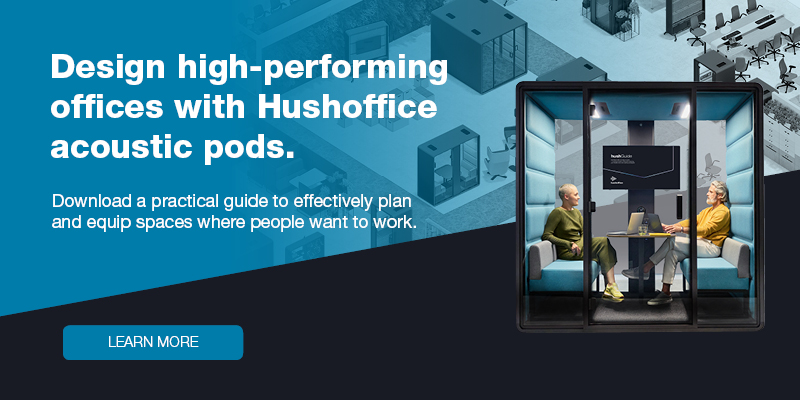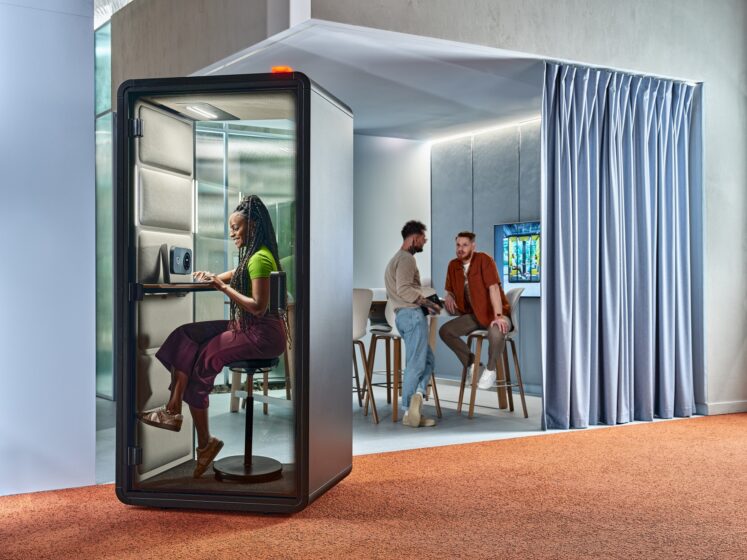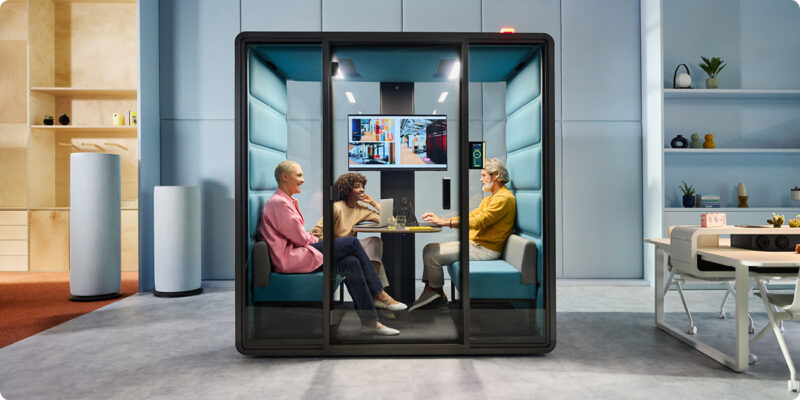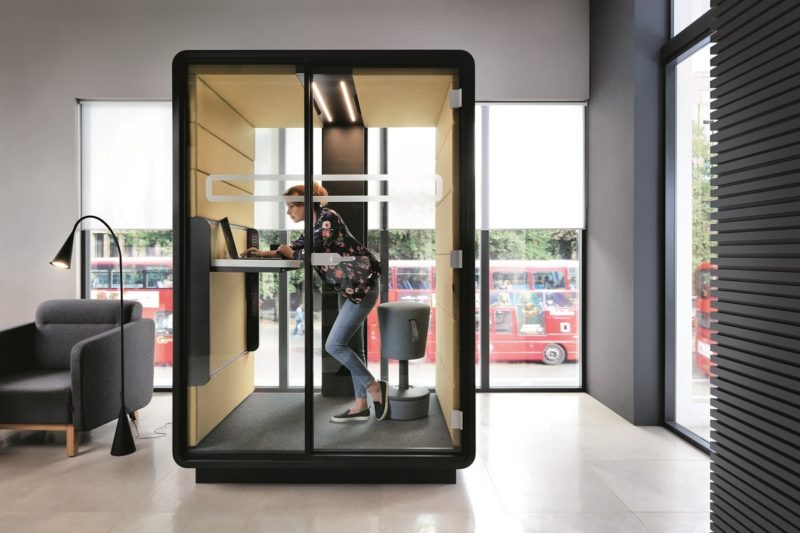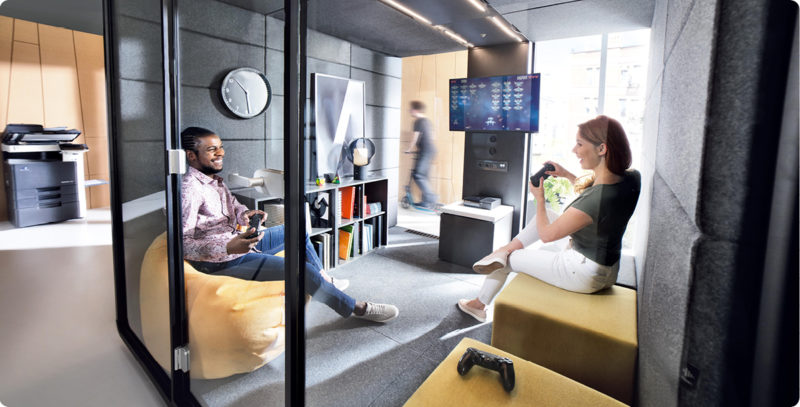Creating an activity-based workspace (and how office pods can support it)
- Posted on: 31 January 2024
- By: Hushoffice Team
The activity-based working method is becoming increasingly popular as it allows to address employees’ needs while reducing expenses. But what are its advantages and disadvantages? And how can office design bolster the success of the ABW framework? Let’s take a look.
Activity-Based Workspace – tl;dr
Activity-based working (ABW) refers to a work style and organisational framework that favours task-specific working environments over designated workstations. An office designed with ABW principles in mind is divided into a variety of zones, each of which supports a specific set of activities. The availability of diverse working areas supports employee autonomy over their workday, allowing them to choose the environment that meets their exact needs depending on the task at hand.
According to research, the pitfalls of ABW are more connected with how effectively the concept is implemented in the physical workspace and how employees use it than the framework itself. In a nutshell, the success of activity-based working depends mostly on how effectively it is supported by the office environment. Remarkably, one study revealed that the comfort of furnishing is the single strongest predictor for self-evaluated health status of workers in an activity-based workspace.
Generally, in order to meet different employee needs and expectations, an ABW workplace typically features open lounges, collaboration areas, breakout areas, project tables, cafes, co-working spaces, conference facilities, and private, quiet booths, such as Hushoffice pods.
What does activity-based working (ABW) refer to?
Activity-based working (ABW) refers to a work style and organisational framework that favours task-specific working environments over fixed workstations. An office designed according to ABW principles provides employees with a wide range of work settings (from collaboration areas to quiet zones to office pods, such as HushWork) to choose from depending on the nature of their tasks.
With its task-focused, individualised character, an ABW approach to office design is becoming increasingly popular. It helps optimise the use of office space while supporting many different work styles, and, consequently, improving overall organisational efficiency and employee satisfaction
– says Mateusz Barczyk, Senior Brand Manager, Hushoffice.
ABW is transforming the workplace
With its principles applied to office design, activity-based working becomes a human-centric design ethos that aims at providing workers with plenty of spaces to work, relax, and socialise. Preferably, these work arrangements are flexible and adjustable, fitted with mobile furniture that ensures maximum user adaptability.
The range of work settings will vary from organisation to organisation.
Generally, an ABW workplace includes open lounges, collaboration areas, breakout areas, project tables, cafes, co-working spaces, conference rooms, private areas, quiet retreats and phone pods, such as hushPhone.
Are there any shortcomings of ABW settings?
It has been proved that the pitfalls of ABW are more connected with how effectively the concept is implemented in the physical workspace and how employees use it rather than with the framework itself. So, the success of activity-based working depends mostly on how effectively it is supported by the office environment.
The key is to allow employees to modify and adjust the layout
One review of the research on ABW over the last ten years has shown that transitioning to an ABW-based environment requires an ongoing assessment of employee attitudes to the office functionality. Such assessment is necessary to measure and address the changing needs and expectations, contributing to the overall success of the ABW working implementation.
There are numerous benefits of an ABW office arrangement
Activity-based working fosters flexibility by giving workers choice over workspaces that align with their work activities. Additionally, it can optimise space, minimising the need for fixed workstations. When given choice, employees can effortlessly switch between individual focus, collaborative work, and relaxation, which boosts their productivity and wellness.
So, are there any universal needs that all employees share?
To perform at their best, employees need autonomy and support. Activity-based working is a promising solution that grants workers the autonomy they need by providing them with a variety of working environments to choose from and the freedom to change spaces depending on their daily work activities.
Activity-based office design is about careful planning of the workspace in order to support various working styles and tasks
– says Mateusz Barczyk, Senior Brand Manager, Hushoffice.
The future of work means a flexible, people-based approach.
According to 34% of workers, lack of flexibility negatively influences their productive output. Among these employees, there is a clear common request for the opportunity to choose work environments both within and outside the office. In fact, in-office flexibility seems to be an essential factor in employee performance.
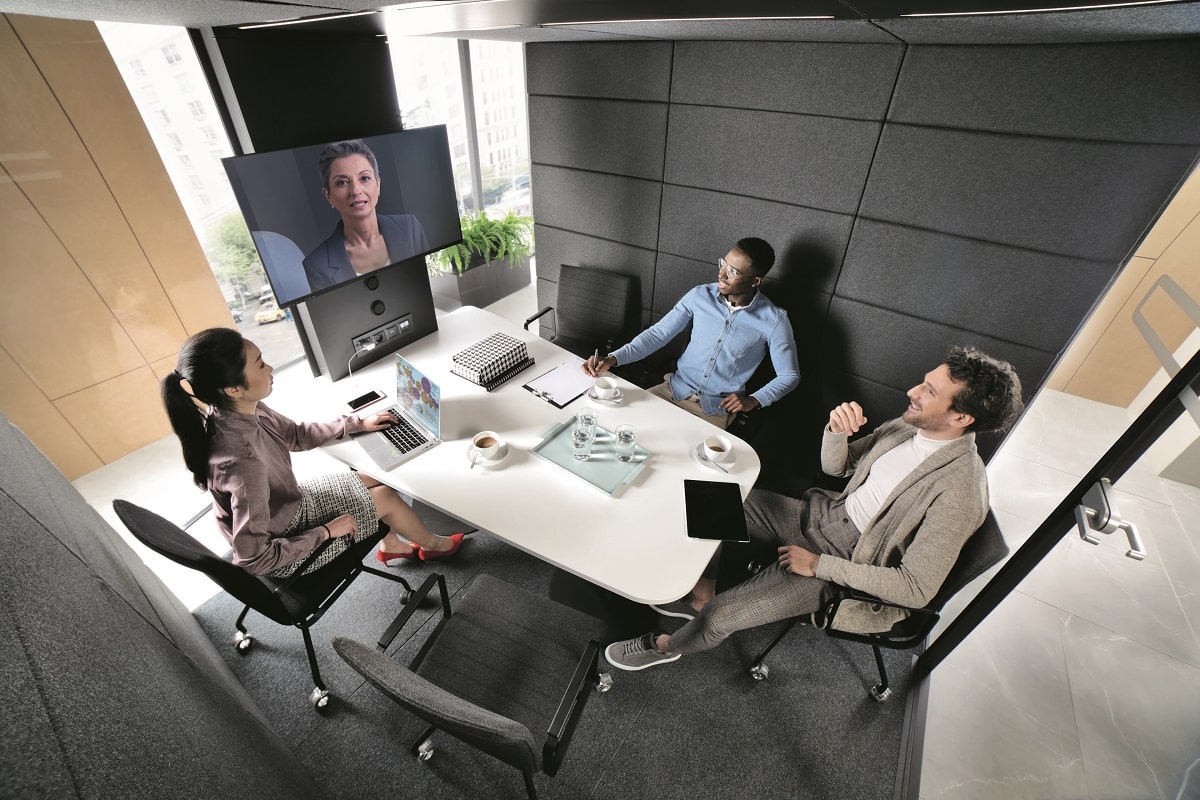
Different generations mean different working styles
Different generations have different expectations from their workspace. While traditionalists look for private meeting areas, millennials appreciate resimercial design. Generation X enjoys open, transparent layouts. By providing employees with a wide range of discrete zones, ABW can address all these varying, overlapping needs.
Hushoffice acoustic booths are designed to accommodate various task requirements
So where do pods come into play? Office pods are fully-equipped, self-contained, mobile, private and pleasantly quiet spaces for working, meeting, and relaxing. They can be customised to accommodate a variety of work-related activities, providing teams with environments suited to a wide range of work functions.
Support for a variety of working styles
Understanding and categorising tasks enables you to define and enhance environments that support each of them, considering their unique characteristics. By doing so, you gradually, but effectively create work environments that accommodate a whole range of work styles within the workspace
– says Mateusz Barczyk, Senior Brand Manager, Hushoffice.
Private spaces, such as booths, are not a universal meeting solution for everyone. There are extroverts and lively individuals around us and they clearly prefer to meet in more social, dynamic settings. Such employees will find semi-enclosed office booths, such as hushMeet.open, far more attractive.
Get rid of silos to enhance team relations
Casual watercooler chats can balance collaborative discussions by promoting reciprocity. Engaging in small talk while working together fosters an enjoyable two-way flow of conversation, allowing everyone to participate. This phenomenon is connected with increased levels of task enjoyment.
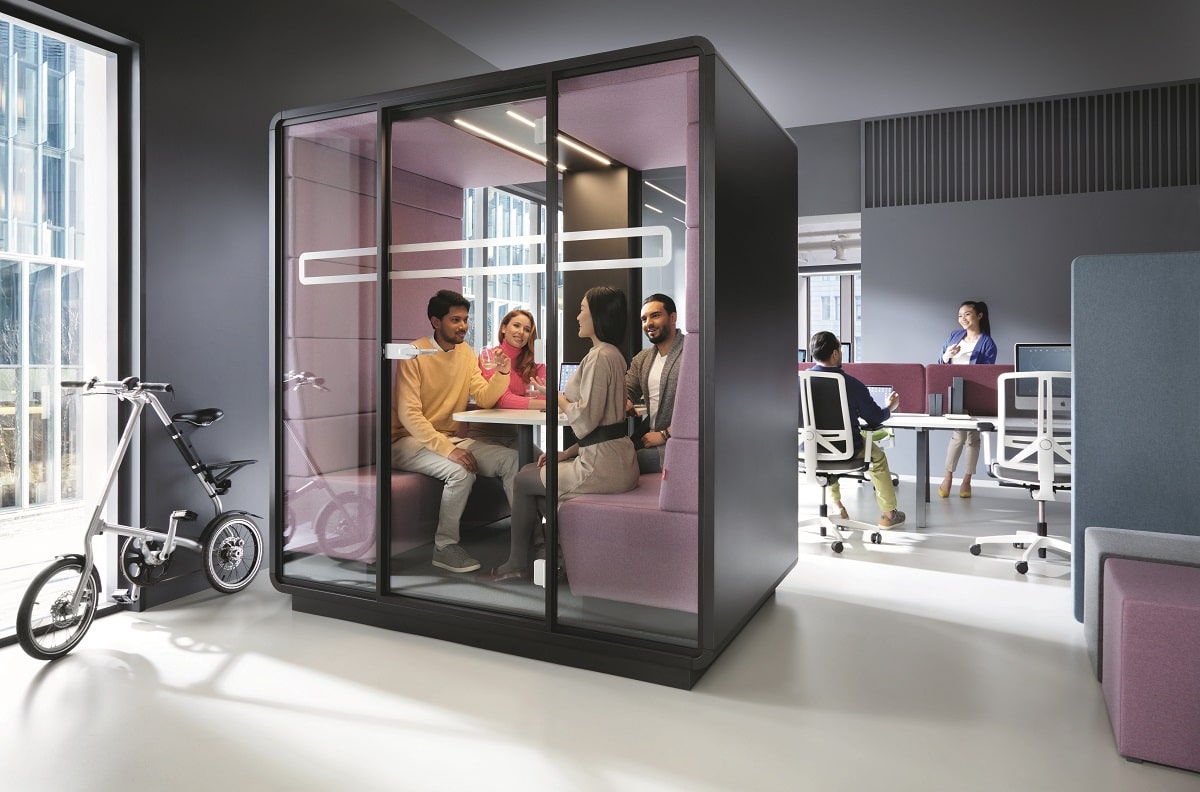
Autonomy in the office comes with many benefits
On average, organisations that adopt activity-based working experience a 17% increase in overall workplace satisfaction, 13% improvement in employee productivity, 8% boost in team productivity, 11% gains in company culture and 4% increase in community spirit.
However, there are many factors contributing to the overall success of activity-based working.
According to the leading research, the results of the activity-based working model depend on the alignment between employee work styles and the support from their work environment, employees’ genuine sense of autonomy as well as the flexibility and mobility that an organisation offers.
Private workspaces are crucial for creating a flourishing activity-based office environment
Undoubtedly, ABW can increase the frequency of personal, interdepartmental, and informal communication among both employees and managers, contributing to enhanced performance and creativity. However, the data suggests that there is one condition: employees must be provided with closed workspaces. Otherwise, an open-plan layout causes distractions and hinders concentration.
Certainly, the right furniture can make or break activity-based working.
Type of furniture sends a clear message about the purpose of each work setting, making the workspace much more intuitive. If it fails to communicate well, your team members will struggle to navigate the office, feeling confused about how it should actually be used.
Is furniture really so important?
One study revealed that the comfort of furnishing is the single strongest predictor for self-evaluated health status of workers in an activity-based workspace. With these findings in mind, our team loves to present our Hushoffice family of booths that are elegantly upholstered and finished with ergonomic, user-friendly furniture.
Acoustic cabins foster cooperation, interaction, relaxation, and focus
Summing up, the workplace must accommodate employees’ most important needs and expectations to evolve into a successful ABW organisation. Pods and booths can support this process by dividing the workspace into zones dedicated to different work activities and introducing a healthy amount of privacy and quiet onto the floor.
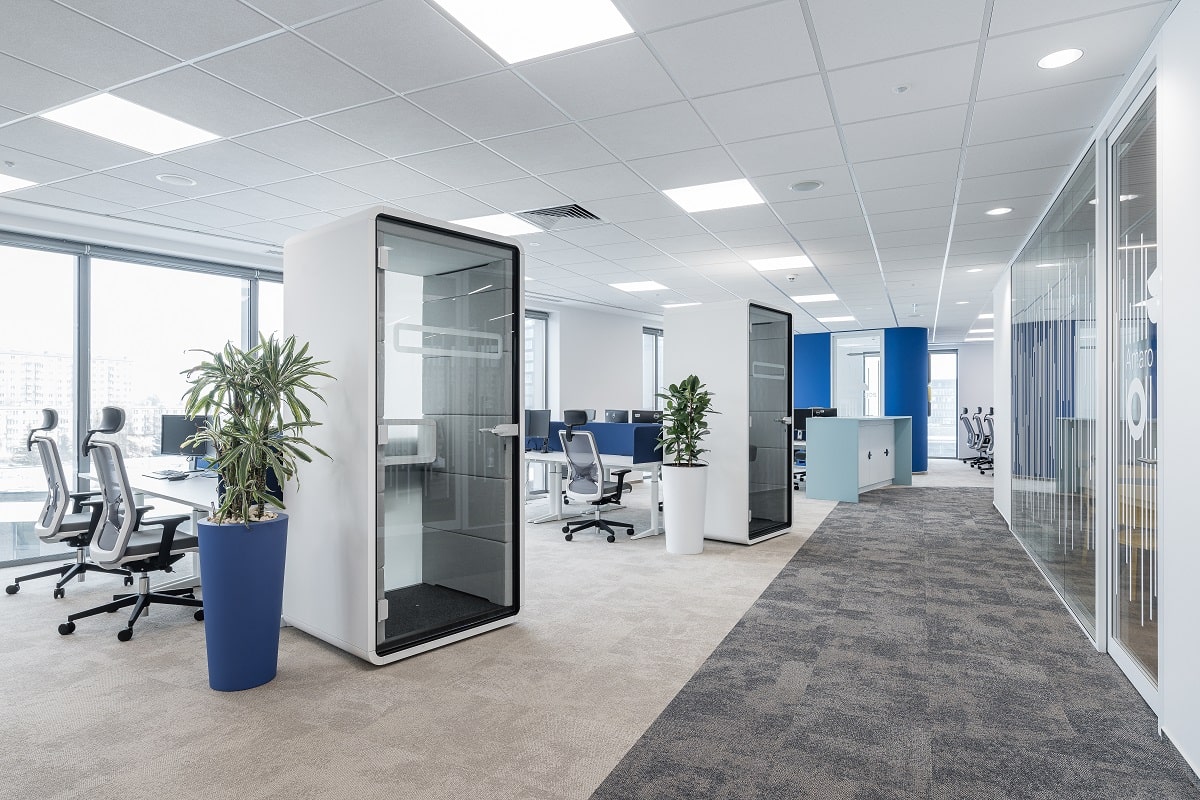
Focus areas to work in silence
According to 80% of office workers, their productivity depends on access to quiet, private workspaces. A one-person office booth, such as hushHybrid, makes an ideal private workspace: it is comfortably furnished and equipped with all the features favourable for focus within the noisy open-plan office environment.
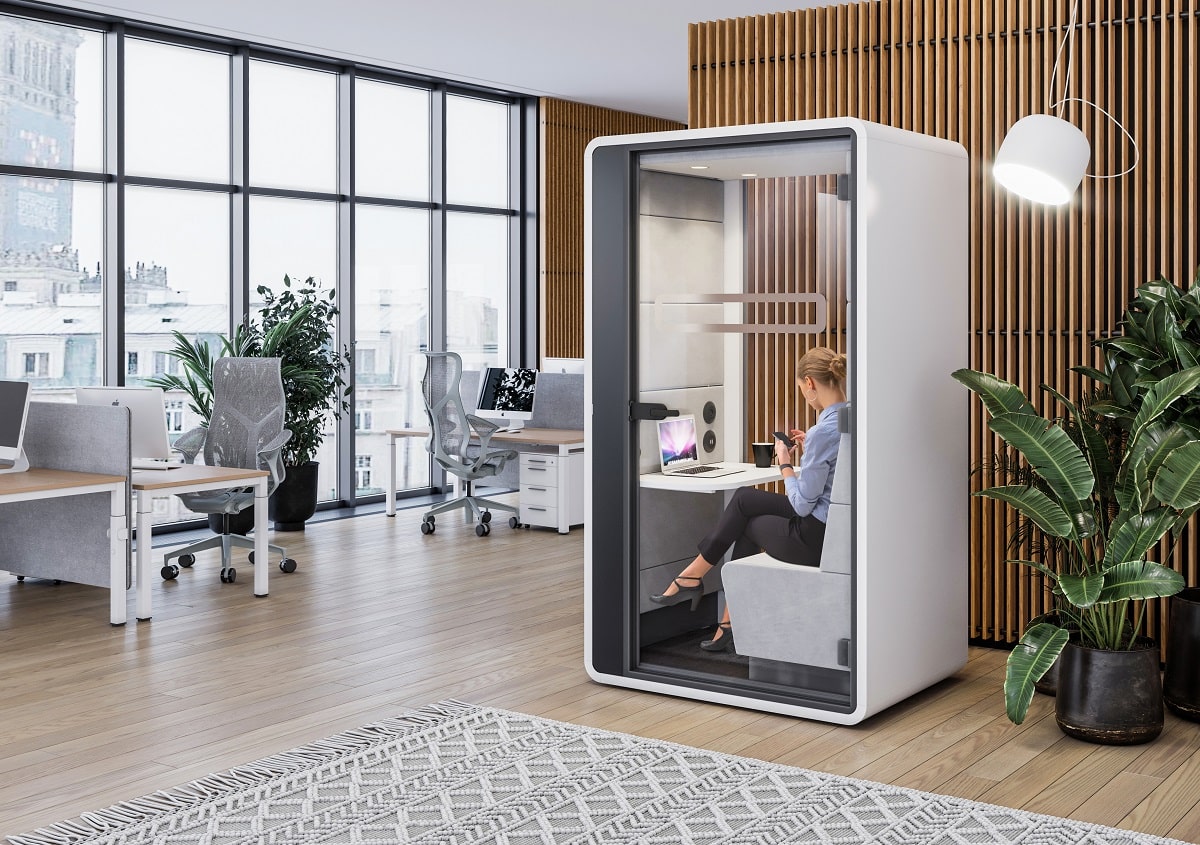
Talking instead of emailing
Digital overload may result in irritability, anxiety, and mood swings. Simultaneously, in-person communication is still one of the most efficient ways to address our need for socialisation. HushMeet, a cosy 4-person work pod, is all you need to encourage natural, spontaneous interactions.

Small meeting rooms for discussions, brainstorming sessions, and get-togethers.
A quaint booth, such as hushMeet.S, is a perfect solution to satisfy employees’ natural need for socialising. It is acoustically designed to contain all speech made inside, ensuring full confidentiality of conversations. With its self-contained design, hushMeet.S is a privacy haven, too.
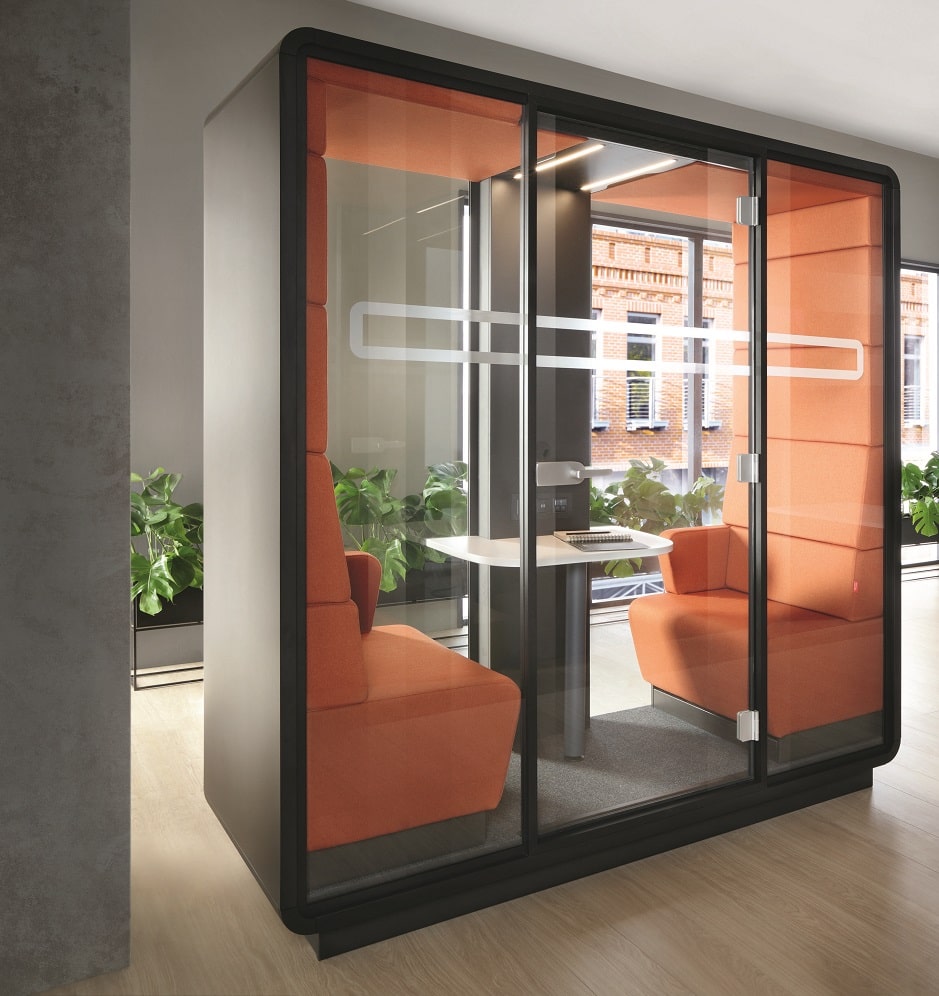
Relaxation zones allow you to take five whenever you need to.
Sometimes, all you need to recharge your batteries is a few moments away from the figurative (and literal) noise. HushMeet.L has been carefully designed to provide this opportunity. Once you step inside the booth, the office hubbub becomes just a distant, gentle, soothing murmur.
The office of the future: a variety of spaces and the choice left to employees
The data suggests that the success of an ABW workspace largely depends on spatial factors, such as ease of interaction, the adjustability of work environments, and the amount of storage space offered. The significance of adequate furniture and a well-considered layout in ABW cannot be emphasised enough!
Eventually, the contemporary office must address employees’ growing desire for choice.
Begin strategically and gradually diversify your open-plan workspace by dividing it into functional feng-shui zones tailored to address specific work- and health-related needs. Offering employees options that come with well-suited furniture arrangements provides them with an opportunity to discover their most effective workflow within the workplace.
Want to learn more? Learn how activity-based design can boost office ergonomics.
Activity-based Workspace – summarized
Activity-based working (ABW) refers to a work style and organisational framework that favours task-specific working environments over designated workstations. An office designed with ABW principles in mind is divided into a variety of zones each of which supports a specific set of activities. The availability of diverse working areas supports employee autonomy over their workday, allowing them to choose the environment that meets their exact needs depending on the task at hand.
According to research, the pitfalls of ABW are more connected with how effectively the concept is implemented in the physical workspace and how employees use it than the framework itself. In a nutshell, the success of activity-based working depends mostly on how effectively it is supported by the office environment. Remarkably, one study revealed that the comfort of furnishing is the single strongest predictor for self-evaluated health status of workers in an activity-based workspace.
Generally, in order to meet different employee needs and expectations, an ABW workplace typically features open lounges, collaboration areas, breakout areas, project tables, cafes, co-working spaces, conference facilities, and private, quiet booths, such as Hushoffice pods.
Activity-Based Workspace – frequently asked questions
What does an ABW approach look like in practice?
A workspace following the ABW principles consists of zones dedicated to specific tasks. These zones include collaborative spaces, breakout areas, work lounges, project tables, cafes, cooperative seating arrangements, conference rooms, and private, self-contained booths, such as Hushoffice pods.
What are the main rules of activity-based working?
The cornerstone of activity-based work is the idea that employees should be given autonomy in their workplace by being provided with options and choices. Only then can the workers find their own optimum workflow and perform at their best. One of the most effective ways to grant such autonomy is to introduce diversity into the open-plan office. This can be achieved by dividing the workspace into a number of zones that offer various work settings to choose from, depending on employees’ current needs.
What’s the definition of an activity-based office design?
Also referred to as activity-based working (ABW), an activity-based office design emphasises flexibility and employee autonomy. Its main idea is to provide a wide range of different workspaces dedicated to specific tasks, rather than offer employees fixed workstations.

